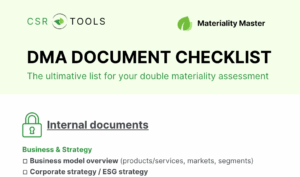A solid Double Materiality Assessment (DMA) isn’t built on assumptions, it’s built on evidence. And under the Corporate Sustainability Reporting Directive (CSRD) and the European Sustainability Reporting Standards (ESRS), that evidence should be traceable, auditable, and grounded in your company’s actual data and context.
Yet many companies jump straight into stakeholder interviews or rating workshops without a crucial first step: collecting the right internal and external documents.
In this article, you will get a DMA Document Checklist. A curated list of the key resources that will make your assessment not only faster and more robust, but also audit-ready and aligned with the expectations of regulators, investors, and auditors. Whether you’re just getting started or already halfway through your materiality process, this guide will help you:
- Know which documents are helpful,
- Understand why these documents matter,
- Know when in the DMA process they are needed, and
- Avoid the chaos of a rushed data scramble when it’s time to report.
Let’s break down the must-have internal and external resources you need. And if done smartly (and applying some AI), these documents are 80% of your Double Materiality Assessment work, before you even engage your first stakeholders.
Why Are Solid Inputs Non-Negotiable For Your DMA?
Under the CSRD, even after the Omnibus proposal, a Double Materiality Assessment isn’t just a formality, it’s the backbone of your sustainability reporting. And that backbone needs to be built on evidence, not assumptions.
Here’s why collecting the right documents early is essential:
- Prove Your Judgments: CSRD and ESRS require you to justify what’s material and why. That means backing up impact and risk assessments with data and not just internal opinions. Without documentation, your decisions might not hold up under scrutiny.
- Audit-Readiness: Auditors will ask: “Where did this issue come from?” and “How did you assess its significance?”. Having a clear audit trail shows you’ve followed a structured, defensible process.
- Better Inputs = Better Prioritization: Solid data helps you to make better decisions:
- Spot overlooked risks or impacts
- Support ratings with real figures
- Align financial materiality with actual exposure
- Save Time: Waiting until stakeholder engagement or ESRS mapping to gather data causes delays, gaps, and rework. Build your DMA evidence base upfront to stay ahead.
- AI-Readiness: In case you plan to leverage AI for your DMA, these resources are crucial to personalize the definition and rating of your IROs according to your organization and gain valuable insights instead of generic output.
DMA Document Checklist: Which documents are valuable?
Let’s look at which internal and external resources should be on your DMA document checklist. Ideally, you select a DMA software such as Materiality Master, which allows you to add documents seamlessly to your materiality analysis.

Internal Resources
Before you look outward, start by digging into what you already have. Most companies sit on a wealth of internal information that’s directly relevant to the Double Materiality Assessment, they just haven’t connected the dots yet.
These internal resources form the core of your evidence base. They help identify relevant IROs, support your scoring, and ensure your DMA aligns with your actual business model and operations.
1. Business & Strategy
These documents help define your context and surface known risks:
- Business model overview (products/services, markets, segments)
- Corporate strategy / ESG strategy
- Annual reports & financial statements
- Risk register / enterprise risk management (ERM) documentation
- Sustainability or non-financial reports (past years)
- Code of conduct / Supplier code of conduct
- Other policies (HR, compensation, values …)
🔍 Use them to: Map your value chain, identify internal risk perceptions, and assess governance structures.
2. Operations & Value Chain Data
Key for identifying actual and potential impacts across your value chain:
- Location of operations (own sites and supply chain geographies)
- (Environmental) Risk Assessment per location (from insurer)
- Supply chain mapping & procurement data
- Customer segmentation
- Product life cycle assessments (LCA) or carbon footprints
- Environmental/resource use data (energy, emissions, water, waste)
- HR data (turnover, diversity, health & safety, training)
🔍 Use them to: Identify environmental impacts and upstream/downstream risks.
3. Stakeholder Engagement
People and other stakeholder-related impacts are a major focus under ESRS. These documents matter:
- Previous stakeholder surveys or interview notes
- Complaints, grievance mechanisms and whistleblower reports
- Customer satisfaction data or reviews
- Employee surveys or feedback reports
- NGO correspondence or civil society input
🔍 Use them to: Assess social impacts and human rights risks, especially for ESRS S1–S4 topics.
By organizing these internal resources early, you’ll build a DMA backbone that’s based on real data. This improves the quality of your assessment, and saves time later when mapping to ESRS datapoints or collecting the data.
External Sources
Internal data shows how your company operates. But external sources help you understand how your company is perceived, what stakeholders expect, and which sustainability issues are emerging in your sector, geography, or value chain.
Ignoring external input is one of the biggest reasons DMAs fail the “double” materiality test, especially when it comes to identifying impacts beyond your immediate control.
Here are the most valuable external sources to include in your DMA Document Checklist.
1. ESG Frameworks & Regulatory Standards
These define what’s considered material from a regulatory and investor perspective — especially under CSRD/ESRS.
- EFRAG guidance (e.g., IG1 for Double Materiality), ESRS datapoints & working papers
- ISSB / SASB Materiality Map (for sector-specific financial relevance)
- GRI Standards & sector supplements
- CDP, TCFD, and SBTi disclosures
- EU Taxonomy & SFDR Principal Adverse Impact (PAI) indicators
🔍 Use them to: Align with the EU sustainability reporting ecosystem and identify disclosure-relevant issues.
2. Sector & ESG Benchmarks
See how your industry peers are evaluated and what ESG analysts are watching:
- SASB Materiality Map (sector-specific)
- CDP scores and disclosures
- TCFD sector guidance
- MSCI, Sustainalytics, ISS ESG sector reports (if available)
- GRI sector standards
- Peer sustainability reports (especially leaders in your sector)
🔍 Use them to: Identify common material topics, reputational risks, and market expectations.
3. Scientific, NGO and other Sources
These are critical for impact materiality, especially regarding climate, biodiversity, and social issues.
- IPCC reports (climate science & risk scenarios)
- Science Based Targets initiative (SBTi)
- WWF Risk Filter, IUCN, UNEP, and other biodiversity impact tools
- ILO conventions, UN Guiding Principles, OECD Guidelines
- NGO reports (e.g. Amnesty International, Human Rights Watch)
- Other scientific studies (e.g. correlation between business success and diversity)
🔍 Use them to: Strengthen the severity, scope, or irremediability assessments of identified impacts.
These external resources are not just for identifying issues, they’re also powerful tools to challenge internal blind spots, spot emerging trends, and validate stakeholder concerns.
💡 Note: At Materiality Master we have created a broad database of such studies that are leveraged by our AI agent.
When do you need these resources from the DMA document checklist?
Collecting documents is not just a box-ticking exercise; instead, it’s about using the right resources at the right moment in your Double Materiality Assessment. Here’s how internal and external information supports each stage of the process:
1. Define Scope & Understanding The Context
Useful Documents:
- Business model & strategy
- Value chain documentation
- List of products and services
- Past sustainability reports
Financial statements
2. Identify Impacts, Risks & Opportunities (IROs)
Useful Documents:
- Location (Risk) Assessments
- Risk register or excerpt of enterprise risk management tool
- HR reports and employee survey results
- Sector benchmarks (e.g., Sustainability Reporting Navigator (SRNAV) or EFRAG ‘State of Play’ Report)
- ESG ratings, incident logs, whistleblower reports
Benefits: These sources form the longlist of potential material topics. Without them, you’ll miss critical IROs or rely too heavily on opinions.
3. Classify & Rate IROs
Useful Documents:
- Operational KPIs (e.g. emissions, safety)
- Financial data and scenario analyses
- Scientific or external data (e.g. IPCC, SBTi)
- Stakeholder feedback and interview transcripts
- Policies (internal and external)
Benefits: This is where you assess severity, scale, likelihood, and financial magnitude. Documentation gives credibility and consistency to your scoring.
DMA Document Checklist Conclusion: Do the Prep, Win the Process
A successful Double Materiality Assessment starts with documents. The right internal and external resources give you the context, evidence, and credibility you need to make informed, auditable, and CSRD-compliant decisions.
By following this DMA Document Checklist, you:
- Cover 80% of the groundwork before the real analysis begins,
- Avoid costly backtracking during ESRS mapping or assurance,
- And build a foundation for faster, more focused stakeholder engagement.
In short: better inputs = better outcomes.
So whether you’re just getting started or revisiting your approach, now is the time to gather and organize your evidence base. It’s the fastest path to a DMA that stands up to internal review, external scrutiny, and regulatory expectations.


